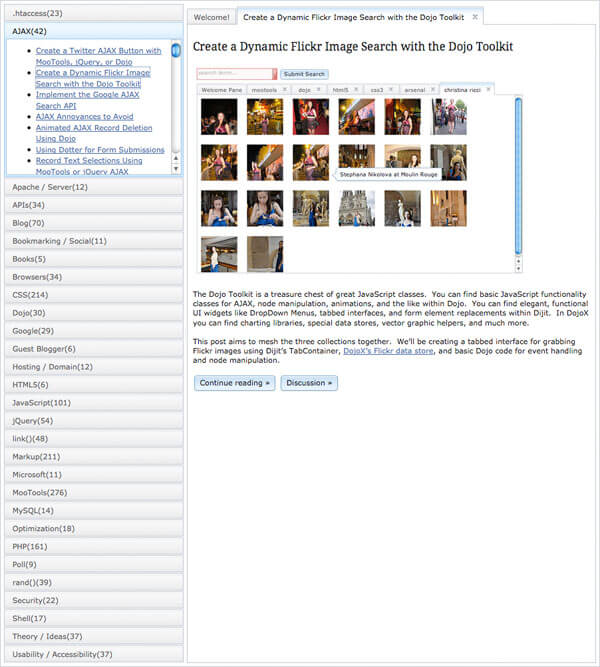Create a Download Package Using MooTools Moousture

Zohaib Sibt-e-Hassan recently released a great mouse gestures library for MooTools called Moousture. Moousture allows you to trigger functionality by moving your mouse in specified custom patterns. Too illustrate Moousture's value, I've created an image download builder using Mooustures and PHP.
The XHTML
<div id="messager">Waiting for you to select images...</div> <img src="preload-images/1.jpg" alt="Image 1" width="100" class="moouse" /> <img src="preload-images/2.jpg" alt="Image 2" width="100" class="moouse" /> <img src="preload-images/3.jpg" alt="Image 3" width="100" class="moouse" /> <img src="preload-images/4.jpg" alt="Image 4" width="100" class="moouse" /> <img src="preload-images/5.jpg" alt="Image 5" width="100" class="moouse" /> <img src="preload-images/6.jpg" alt="Image 6" width="100" class="moouse" /> <img src="preload-images/7.jpg" alt="Image 7" width="100" class="moouse" /> <img src="preload-images/8.jpg" alt="Image 8" width="100" class="moouse" /> <div style="clear:both;"></div> <input type="submit" name="download" id="download" class="button" value="Download Package" />
We provide the images, a messenger DIV which lest the user know when an image has been added and removed, and a submit button to generate the file.
The CSS
#messager { padding:10px; border:2px solid #fc0; background:#fffea1; margin-bottom:10px; }
.unselected { border:2px solid #ccc; background:#fff; }
.selected { border:2px solid #3b5998; background:lightblue; }
.moouse { width:100px; float:left; margin:0 20px 0 0; padding:5px; }
Nothing special, except that the selected class should make it very apparent to the user that the image has been selected.
The MooTools JavaScript
/* dom ready */
window.addEvent('domready',function() {
/* add to each image */
$$('img.moouse').each(function(img) {
/* add unselected class */
img.addClass('unselected');
/* create the gesture */
var gest = new Moousture.ReducedLevenMatcher();
/* set the "add" and "remove" gestures */
gest.addGesture([4,5,6,7,0,1,2,3], function(error) {
/* good gesture! */
if(error < 3) {
img.addClass('selected');
document.id('messager').set('text','Image ' + img.get('alt') + ' added.');
}
/* bad! */
else {
//document.id('messager').set('text','Sorry - we couldn\'t detect that you wanted: ' + img.get('alt') + '.');
}
}); //add
/* set the "add" and "remove" gestures */
gest.addGesture([4,3,2,1,0,7,6,5], function(error) {
/* good gesture! */
if(error < 3) {
if(img.hasClass('selected')) {
img.removeClass('selected');
document.id('messager').set('text','Image ' + img.get('alt') + ' removed.');
}
}
/* bad! */
else {
//document.id('messager').set('text','Sorry - we couldn\'t detect that you wanted: ' + img.get('alt') + '.');
}
}); //add
/* add the probe to the image */
var probe = new Moousture.MouseProbe(img);
/* create the recorder */
recorder = new Moousture.Recorder({maxSteps: 20, minSteps: 8, matcher: gest});
/* monitor the image */
monitor = new Moousture.Monitor(30, 2);
/* start monitoring */
monitor.start(probe, recorder);
});
/* submission */
document.id('download').addEvent('click',function() {
/* get the selected images */
var selected = $$('img.selected');
if(selected.length) {
var qstring = '?images=';
/* for each image */
selected.each(function(img) {
/* add to qstring */
qstring += img.get('src') + ';';
});
/* force download */
window.location = 'moousture.php' + qstring;
}
});
});
When the DOM is ready, we set up two gesture patterns for each image -- one to select an image, one to unselect the image. When the user has selected the images they want and click the submit button, Moo redirects them to a PHP address with the images in the $_GET['image'] variable.
Note that the "error" threshold I've set is 3. If a user attempts a gesture on an image, an error number is automatically calculated. This error number represents how different the user's gesture was than the given gesture listener.
The PHP
/* if we got images */
if($_GET['images']) {
/* split the querystring */
$images = explode(';',$_GET['images']);
$valid_files = array();
/* for every image */
foreach($images as $image) {
/* if the image exists */
if(file_exists($image)) {
/* add it to our good image list */
$valid_files[] = $image;
}
}
/* if we have good images */
if(count($valid_files)) {
/* files */
$destination_folder = 'image-packages';
$filename = time().'.zip';
$path = $destination_folder.'/'.$filename;
/* create zip! */
$zip = new ZipArchive();
if($zip->open($path,ZIPARCHIVE::CREATE) !== true) {
return false;
}
/* add the files */
foreach($valid_files as $file) {
$zip->addFile($file,$file);
}
/* close the zip */
$zip->close();
/* force download zip */
if(ini_get('zlib.output_compression')) { ini_set('zlib.output_compression', 'Off'); }
header('Pragma: public');
header('Expires: 0');
header('Cache-Control: must-revalidate, post-check=0, pre-check=0');
header('Last-Modified: '.gmdate('D, d M Y H:i:s', filemtime($path)).' GMT');
header('Cache-Control: private',false);
header('Content-Type: application/zip');
header('Content-Disposition: attachment; filename="package.zip"');
header('Content-Transfer-Encoding: binary');
header('Content-Length: '.filesize($path));
header('Connection: close');
readfile($path);
exit();
}
die();
}
We receive the image paths via $_GET['images']. Once we validate that each image exists, we build the ZIP file and force-download it to the user.
This solution isn't great when there are many images available; a POST method (via form submission) would be best for that situation. What are your thoughts on Moousture though? Any suggestions for the creator?





the demo doesn’t seem 2 wrk, anyway cool example!
Nice idea, but nothing for the wild. I would prefer some selection like you can do it within your explorer (for example).
no sorry, it was me.. the demo works fine.. :)
Cool, but impractical
Probably impractical today, but will have much more use in the future when people aren’t using mouses.
Damn, circling images is hardly a good way to select them…how ’bout just a normal click?
It took me quite a while to select 4 images…that’s after figuring out that I had to circle them…
Even if the mouse were to be replaced with a different device (say like Minority Report), in this particular case, it’s still easier to just “touch” (select) the image, rather than have to draw circles around each image. If in the future we have to draw small circles around everything we want to interact with, I’ll have to remain living in the past. ;)
If I could select more than one image with a larger circle, that may be a bit more useful, but it’s still imprecise, and the lack of feedback (perhaps a trail of what my circle looks like would help) can make it a bit frustrating. Just moving the mouse around the page (and not actually trying to select anything) can cause images to be selected/de-selected.
I know it’s just a tech demo, but perhaps some criticism can help push the demo into something more practical. :)
the first time look the demo didn’t work but when i noticed that the number above is changing then i hit the download it works.. nice idea thanks.
@Jay: Very valid point. A multi-grab would be awesome. I’ll take a look at that — thanks for the idea.
Not having much luck in Firefox 3.5 on the mac.
Managed to select an image after several attempts but no luck in unselecting.
Must admit that a quick click is simpler ;)
Ah, got it, you need to draw the circle “on” the image and not “around” it.
Works perfectly like that. Maybe the instructions could be a bit clearer ;)
I’m waiting for someone to write some kind of Javascript game with this technology. Seems like the more likely use and would be quite cool.
Nope, no matter what I try – doesn’t work! circling in such tight quarters cumbersome at best – should be a much more efficient way of selecting than making a full circle around it.
I like checkboxes better because they work.
Wow, super-intuitive. Maybe even worse than the likes of FancyForm…
when i download zip file from Internet Explorer that will not open and gives error.